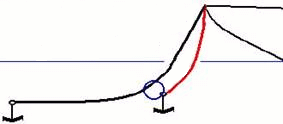Hi all,
After a 2 am fire drill when the wind came up and I had several boats rafted to me I working on increasing holding power in a 50,000 lb power boat.
As a single hander I need equipment that is well thought out and easy to handle in unfriendly conditions.
I'm looking at hooking a spare 45 lb cqr to my main rode (3/8 chain) about 40 feet in front of the main anchor. Since the cqr would come over the roller first on retrieval I need an easy way to unclip it from the main rode.
I'm loathe to trust carabiners and I don't like the way they load the main rode. So far my best answer is just tie the cqr on with about 15 feet 1/2 nylon braid using a rolling hitch.
Thoughts appreciated .....
Jim Slocomb
Friday Harbor
After a 2 am fire drill when the wind came up and I had several boats rafted to me I working on increasing holding power in a 50,000 lb power boat.
As a single hander I need equipment that is well thought out and easy to handle in unfriendly conditions.
I'm looking at hooking a spare 45 lb cqr to my main rode (3/8 chain) about 40 feet in front of the main anchor. Since the cqr would come over the roller first on retrieval I need an easy way to unclip it from the main rode.
I'm loathe to trust carabiners and I don't like the way they load the main rode. So far my best answer is just tie the cqr on with about 15 feet 1/2 nylon braid using a rolling hitch.
Thoughts appreciated .....
Jim Slocomb
Friday Harbor


 wind, 50 ft of water, a 140 lbs anchor with a 250 ft chain scope would be required. However, the present old windlass and my WIFE can not handle a 140 lb anchor and 250 ft of chain.
wind, 50 ft of water, a 140 lbs anchor with a 250 ft chain scope would be required. However, the present old windlass and my WIFE can not handle a 140 lb anchor and 250 ft of chain.  According to the formula increase the scope is almost as good as increasing the weight of the anchor. Also the bottom holding power is a huge factor, and reducing the swing, so its not just the anchor.
According to the formula increase the scope is almost as good as increasing the weight of the anchor. Also the bottom holding power is a huge factor, and reducing the swing, so its not just the anchor. 